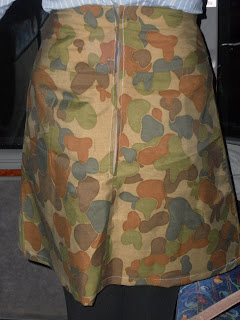

MANUFACTURE PLAN TO CREATE A SLIGHTLY FLARED SKIRT WITH A YOKE.
1. Over lock the bottom of the front yoke.
2. Over lock the yoke line of the top of the front skirt.
3. Placing the two right sides of the fabric together matching the nick in the centre of the fabric. Sew a 1.5cm seam allowance of the centre of the garment to the side seam.
4. Turn the garment over and repeat the process from the centre of the garment to the edge of the side seam.
5. Press the seam open.
6. Over lock the bottom of the back yoke.
7. Over lock the yoke line of the top of the back skirt.
8. Attach the back yoke to the back skirt (x2) using 1.5cm seam allowance. Press open.
9. Over lock CB (x2) join backs (x2) together using a 1.5cm seam allowance.
10. Insert zip into back seam.
11. Attach the front and back skirts together using 1.5cm closed seam.
12. Iron interfacing to front and back facings.
13. Attach front and back facing together using 1.5cm seam allowance.
14. Press side seams open.
15. Over lock facing.
16. Over lock the facing along the back edge and bottom facing.
17. Attach the facing to the skirt matching centre and side seams with a 1.5cm seam allowance.
18. At the edge by the zip turn excess material back.
19. Press the seam allowance towards the facing.
20. Sew a retaining stitch.
21. Sew the facing down following the machine lines from the zips.
22. Over lock the bottom of the skirt and turn up hem line to 2cm and then stitch a 1.5cm top stitch.


 To present my hand embroidery attempts I wanted to layer and overlap different colours and textures to get an idea of what colour scheme I wanted to use for my final design.Out of both these colour schemes I prefer the darker shades of greens, blues and browns as the are deep and rich in colour. Whereas the oranges and pinks are too bright for my garment structure and would overpower the detail of the techniques used. Out of all these techniques I would consider using a cross stitch, beading or seeding as they are the techniques I find easiest and in small areas can look effective.
To present my hand embroidery attempts I wanted to layer and overlap different colours and textures to get an idea of what colour scheme I wanted to use for my final design.Out of both these colour schemes I prefer the darker shades of greens, blues and browns as the are deep and rich in colour. Whereas the oranges and pinks are too bright for my garment structure and would overpower the detail of the techniques used. Out of all these techniques I would consider using a cross stitch, beading or seeding as they are the techniques I find easiest and in small areas can look effective.















































